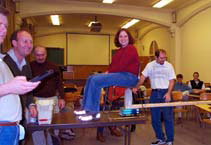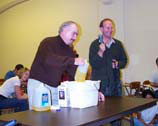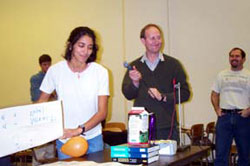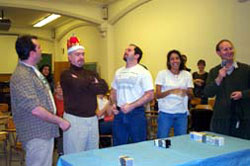Iron Science Teacher Competition Pits East Against West
Athletes have their iron man and iron woman competitions. Culinary artists have "The Iron Chef." Now TC has its Iron Science Teacher competition, thanks to a collaborative effort with San Francisco's Exploratorium Teacher's Institute on December 1st. The Exploratorium has done previous Iron Science Teacher challenges, but this was the first coast-to-coast event.
Coordinated by Assistant Professor Keith Sheppard and Robert Steiner, Associate Director of Leadership Programs in the Distance Learning Program, graduate student/science teachers at Teachers College went head to head with science teachers at the Exploratorium Teacher's Institute in San Francisco. The event was held as a live teleconference in the Goodman Room on the third floor of Milbank Memorial Library. The Exploratorium also broadcast the event live on their Web site, www.explora-torium.edu /iron_science, and it can still be viewed through its archives.
"We had a student in the master's program in educational technology who works all year at the Exploratorium and attends TC in the summer," Sheppard said, explaining how the collaboration came about. The student, Eric Moller, was working on a distance-learning project as part of his coursework under Professor Howie Budin. The Exploratorium does regular Iron Science Teacher competitions, but Eric's association with both TC and the Exploratorium made an east coast vs. west coast challenge a reality.
"I think it's perfect for science teachers," Sheppard said, "because it involves teaching lessons about science that are interesting and that use everyday materials. In New York City you go into a classroom and have no equipment, so it's relevant."
The participating New York teachers are graduates or current graduate students of Teachers College. They included Rob Stoll of Bronx High School of Science, Sam Zimmerman of Baruch College School in Manhattan, Dennis Robbins formerly of Sacred Heart School in Manhattan and presently a full-time doctoral student at TC, and Jhumki Basu, formerly of the Castilleja School in California and presently a full-time master's student at Teachers College."Two of the TC contenders that were chosen are students here," Sheppard explained. "The other two completed their master's degrees here two years ago. At that time, both had mentioned that they were big fans of the Iron Chef program, so I decided to call and ask them if they'd like to be in the competition for Iron Science Teacher." They both enthusiastically responded, "Yes."
The four contenders from TC and four from the Exploratorium were given what was called a "secret" ingredient to use in putting together a science experiment and then five minutes to teach a lesson about that experiment. The ingredient here was milk cartons.
Competitors created experiments in optics, pressure, chemistry, and the Corealis effect. The California contingent flooded their studio with their various experiments using water. Richard Delwich, using water flowing through a hole in the carton, attempted to demonstrate that light from a laser pointer would follow the stream of water as it would with fiber optics. Though a leak created problems with the outcome of the demonstration, Delwich was able to talk about the concept of fiber optics based on the effort.
Switching to TC, Sam Zimmerman demonstrated the use of a lever to crush a milk carton after showing that the carton could not be crushed simply with the weight of a heavy textbook. When he used the textbook at the end of a lever, "the force was magnified." Zimmerman demonstrated air pressure by putting hot water into a plastic milk jug and then submerging it in ice water, which caused the carton to collapse.
A demonstration of density used trickery by having a young person transfer Styrofoam peanuts from one size container to another to determine how many could fit into each one. The teacher, Vince Hawkins, used acetone in the smaller carton, which shrinks Styrofoam into plastic, to make it look like the smaller carton could hold more peanuts.
At TC, Basu demonstrated positive and negative charges with balloons, paper clips and aluminum foil, and even resurrected a foil "man" with lightning from an electric current.
Again in New York, Robbins demonstrated water pressure by creating leak holes at different levels in a carton filled with water. John Damicus from the Exploratorium countered with a lesson on the Corealis effect by putting water in a carton that let water out with a straw at the bottom. Spinning the carton he showed how water would flow in front of or behind the straw depending on which way the straw was bent and then taught the group why.
At TC, Stoll used small milk cartons to illustrate a number of qualities of light. He made a periscope using cartons and mirrors, made a simulated camera with a carton that was pierced with a hole on one end and painted black inside. He also demonstrated how light bends by shining a laser pointer through a hole and blocked by a filter.
In the end, the winners were determined by audience applause, and the team from TC prevailed.
A future match is being planned for the spring. In addition to watching it on the Explorator-ium Web site, those interested in being part of the audience can attend the contest at TC on the day of the event. Further information will be available once arrangements have been made.
Published Monday, May. 20, 2002



